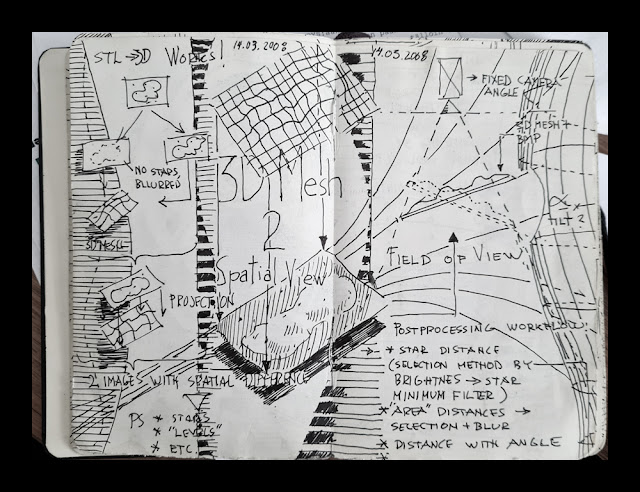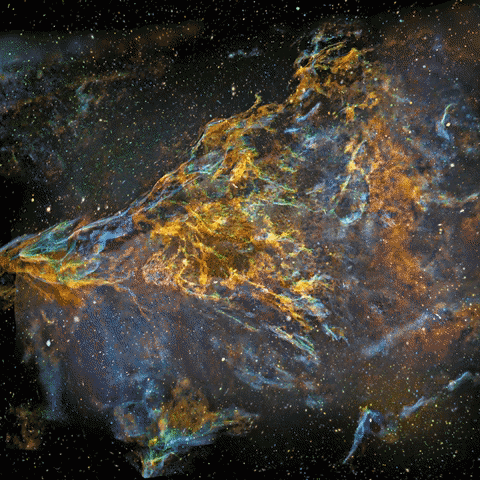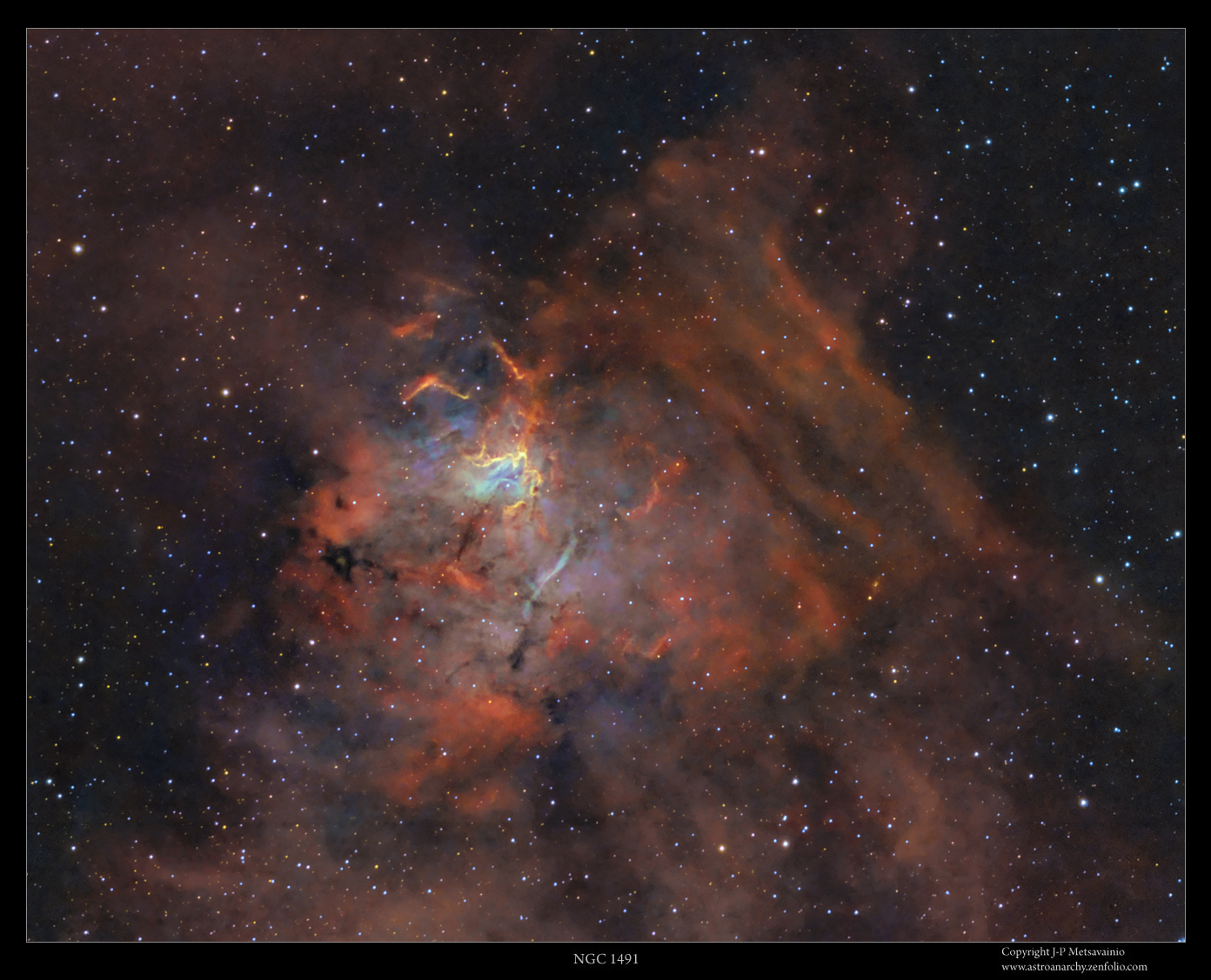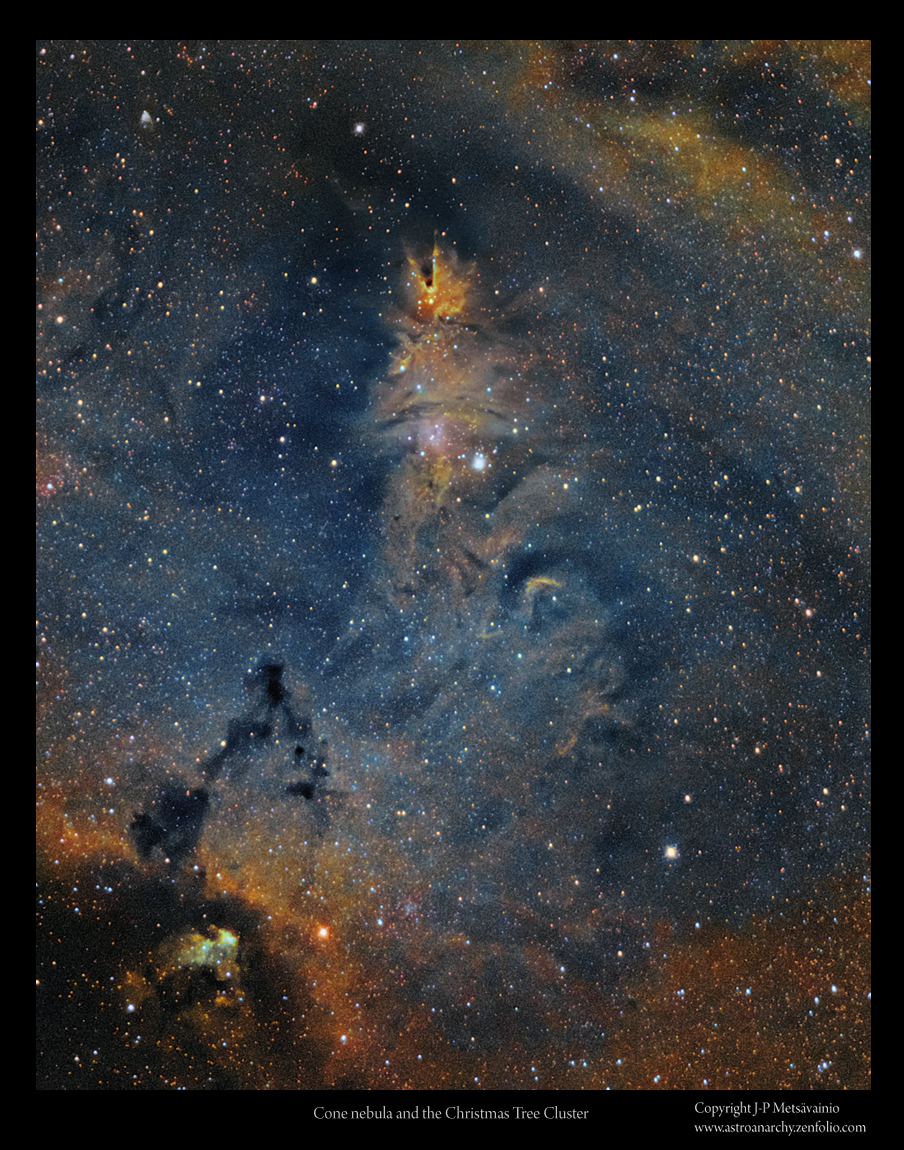COPYRIGHT, PLEASE NOTE
Wednesday, October 6, 2021
Unveiling The Veiled
The Veil nebula supernova remnant in Cygnus. Original image was shot with the Canon EF 200 mm f1.8 camera optics full open, QHY9 astro camera and Baader narrowband filters at 2013.
New data is shot with Tokina 300mm f2.8 camera optics and Celestron Edge HD 11" telescope, Apogee Alta U16 astro camera with Astrodon narrowband filters between 2016 - 2020
Total exposure time is now about 45 hours.
The Veil nebula @SuperRare auction
Animation, https://superrare.com/artwork-v2/unveiling-the-veiled-volume-29145
Photo, https://superrare.com/artwork-v2/unveiling-the-veiled-29137
Veil nebula Unveiled
Click for a large image, 1250 x 1700 pixels
Nebula in visual colors from light emitted by an ionized elements can be seen here,
https://astroanarchy.blogspot.com/2021/09/veil-nebula-unveiled-ii.html
Every single pixel in this 3d-animation is from the original 2D-image above. The model is based on on known scientific facts, deduction and some artistic creativity. The result is an appraised simulation of reality. Astronomical photos are showing objects as paintings on a canvas, totally flat. In reality, they are three dimensional forms floating in three dimensional space. The purpose of my 3d-experiments is to show that and Give an idea, how those distant objects might look in reality.
INFO
How the 3D-model is made
 My Moleskine notebook pages from 2008, I planned how to convert nebulae to 3D
My Moleskine notebook pages from 2008, I planned how to convert nebulae to 3D
Monday, October 4, 2021
Three 3D-conversions out of my astronomical photos
I have made dozens of 3D-conversions out of my astronomical photos. As an artist I like to find a new views to the reality. My models are not just a guesswork, the conversion is based on real scientific data.
At the end of this blog post there is a short explanation, how I do my conversion work.
Original astronomical photo about part of the Veil nebula SNR in O-III light only.
3D-study of Veil Nebula Photo
How 3D-models are made My Moleskine notebook pages from 2008, I planned how to convert nebulae to 3D
My Moleskine notebook pages from 2008, I planned how to convert nebulae to 3D
How accurate my 3-D-visions are depending on how much information I have and how well I implement it.
The final 3-D-image is always an appraised simulation of reality based on known scientific facts, deduction, and some artistic creativity.
After I have collected all the necessary scientific information about my target, I start my 3-D conversion from stars. Usually there is a recognizable star cluster which is responsible for ionizing the nebula. We don’t need to know its absolute location since we know its relative location. Stars ionizing the nebula have to be very close to the nebula structure itself. I usually divide up the rest of the stars by their apparent brightness, which can then be used as an indicator of their distances, brighter being closer. If true star distances are available, I use them, but most of the time my rule of thumb is sufficient. By using a scientific estimate of the distance of the Milky Way object, I can locate the correct number of stars in front of it and behind it.
Emission nebulae are not lit up directly by starlight; they are usually way too large for that. Rather, stellar radiation ionizes elements within the gas cloud and the nebula itself is glowing light, the principle is very much the same as in fluorescent tubes. The thickness of the nebula can be estimated from its brightness, since the whole volume of gas is glowing, brighter means thicker.
By this means, forms of the nebula can be turned to a real 3-D shape. Nebulae are also more or less transparent, so we can see both sides of it at the same time, and this makes model-making a little easier since not much is hidden.
The local stellar wind, from the star cluster inside the nebula, shapes the nebula by blowing away the gas around the star cluster. The stellar wind usually forms a kind of cavity in the nebulosity. The same stellar wind also initiates the further collapse of the gas cloud and the birth of the second generation of stars in the nebula. The collapsing gas can resist the stellar wind and produces pillar like formations which must point to a cluster.
Ionized oxygen (O-III) glows with a bluish light, and since oxygen needs a lot of energy to ionize it, this can only be achieved relatively close to the star cluster in the nebula. I use this information to position the O-III area (the bluish glow) at the correct distance relative to the heart of the nebula.
Many other small indicators can be found by carefully studying the image itself. For example, if there is a dark nebula in the image, it must be located in front of the emission one, otherwise we couldn’t see it at all.
Using the known data in this way I build a kind of skeleton model of the nebula. Then the artistic part is mixed with the scientific and logical elements, and after that the rest is very much like creating a sculpture on a cosmic scale
Thursday, September 16, 2021
Viral Nebula Rocks
IC1396 converted to 3D animation, very first of its kind
NOW on SuperRare
I turned my photo of IC1396 to a 3d-model at 2012 to show that it’s actually a three-dimensional volume floating in three-dimensional space. This artwork is not just a guess work, it’s based on scientific data about the structure of emission nebulae and real distance information.
This animation went viral and it was published by several news media and major websites globally at 2012, links after the photos
Original photo used for the animation
My original photo of emission nebula IC1396
PETAPIXEL, Michael Zhang
Amazing Animated GIFs Capture Nebulae in 3D Using Artificial Parallax
https://petapixel.com/2013/02/20/amazing-animated-gifs-capture-nebulae-in-3d-using-artificial-parallax/
This animation was selected to a Moving the Still exhibition in Miami Art Week 2012
How the 3D-model is made My Moleskine notebook pages from 2008, I planned how to convert nebulae to 3D
My Moleskine notebook pages from 2008, I planned how to convert nebulae to 3D
For as long as I have captured images of celestial objects, I have always seen hem three-dimensionally in my head. The scientific information makes my inner visions much more accurate, and the 3-D technique I have developed enables me to share those beautiful visions with others.
How accurate my 3-D-visions are depending on how much information I have and how well I implement it.
The final 3-D-image is always an appraised simulation of reality based on known scientific facts, deduction, and some artistic creativity.
After I have collected all the necessary scientific information about my target, I start my 3-D conversion from stars. Usually there is a recognizable star cluster which is responsible for ionizing the nebula. We don’t need to know its absolute location since we know its relative location. Stars ionizing the nebula have to be very close to the nebula structure itself. I usually divide up the rest of the stars by their apparent brightness, which can then be used as an indicator of their distances, brighter being closer. If true star distances are available, I use them, but most of the time my rule of thumb is sufficient. By using a scientific estimate of the distance of the Milky Way object, I can locate the correct number of stars in front of it and behind it.
Emission nebulae are not lit up directly by starlight; they are usually way too large for that. Rather, stellar radiation ionizes elements within the gas cloud and the nebula itself is glowing light, the principle is very much the same as in fluorescent tubes. The thickness of the nebula can be estimated from its brightness, since the whole volume of gas is glowing, brighter means thicker.
By this means, forms of the nebula can be turned to a real 3-D shape. Nebulae are also more or less transparent, so we can see both sides of it at the same time, and this makes model-making a little easier since not much is hidden.
The local stellar wind, from the star cluster inside the nebula, shapes the nebula by blowing away the gas around the star cluster. The stellar wind usually forms a kind of cavity in the nebulosity. The same stellar wind also initiates the further collapse of the gas cloud and the birth of the second generation of stars in the nebula. The collapsing gas can resist the stellar wind and produces pillar like formations which must point to a cluster.
Ionized oxygen (O-III) glows with a bluish light, and since oxygen needs a lot of energy to ionize it, this can only be achieved relatively close to the star cluster in the nebula. I use this information to position the O-III area (the bluish glow) at the correct distance relative to the heart of the nebula.
Many other small indicators can be found by carefully studying the image itself. For example, if there is a dark nebula in the image, it must be located in front of the emission one, otherwise we couldn’t see it at all.
Using the known data in this way I build a kind of skeleton model of the nebula. Then the artistic part is mixed with the scientific and logical elements, and after that the rest is very much like creating a sculpture on a cosmic scale
Friday, August 27, 2021
Visions of Veil
This is an experimental test with a 3D-conversion of my astronomical image. Only real elements from the original image are used, there is nothing added but the estimated volumetric information!
NOTE. This is a personal vision about shapes and volumes, based on some scientific data, deduction and an artistic impression.Wednesday, March 16, 2016
4D video of the Veil Nebula SNR
4D video of the Veil Nebula supernova remnant
Original 2D image of the Veil Nebula can be seen here:
http://astroanarchy.blogspot.fi/2013/12/veil-nebula-unveiled.html
Monday, August 3, 2015
A large collection of my experimental 3D-astronomy as a movie
NOTE. This is a personal vision about shapes and volumes, based on some scientific data, deduction and an artistic impression.
A HD video, ~11 min.
Then watch the video in full screen for the best viewing experience.
Friday, July 31, 2015
An experimental 3D-study of an emission nebula Melotte 15
NOTE. This is a personal vision about shapes and volumes, based on some scientific data, deduction and an artistic impression.
My original photo of the Melotte 15 in IC 1805
click for a large image
A blog post about this photo, with the technical details, can be seen HERE
An animated GIF
Video 1
Video 2
Info about the technique used
Tuesday, July 28, 2015
An experimental 3D-study of an emission nebula IC 410
NOTE. This is a personal vision about shapes and volumes, based on some scientific data, deduction and an artistic impression.
My original photo of the IC 410
click for a large image
A blog post about this photo, with the technical details, can be seen HERE
An animated GIF
A flythrough video
A flyby video
A study about the general structure of the IC 410
All pillar like formations are pointing to a source of ionization, the open cluster NGC 1893 at the heart of the IC 410. There are some more dense areas in a gas, able to resist the radiation pressure from young star cluster. Those dense areas, at tip of the pillars, are also potential places for the formations of the new stars. A radiation pressure (solar wind) from the cluster NGC 1893 is forming a hollow space inside a gas cloud, it can be seen in my 3D-studies too.
Stereo images of the IC 410
Parallel and Cross vision stereo pairs. An anaglyph Red/Cyan image (Red/Cyan eyeglasses are needed)
http://astroanarchy.blogspot.fi/2015/02/a-3d-study-of-ic-410-as-free-view.html
A Cross vision stereo pair as a sample, other formats behind the link above.
Info about the technique used
Also, many different estimates are needed for the 3-D model. The final 3-D-image is always an appraised simulation of reality based on known scientific facts, deduction, and some artistic creativity
By using a scientific estimate of the distance of the Milky Way object, I can
Explosions in space are more or less symmetrical, due to that, most of the supernova remnants and planetary nebulae mainly has a ball like appearance .
Wednesday, July 22, 2015
Pickering's Triangle in O-III light, an experimental 3D-study
This is an experimental test with a 3D-conversion of my astronomical image. Only real elements from the original image are used, there is nothing added but the estimated volumetric information!
NOTE. This is a personal vision about shapes and volumes, based on some scientific data, deduction and an artistic impression.
My original photo of the Pickering's Triangle
click for a large image
Pickering's Triangle, in the Veil Nebula, at light of an ionized oxygen alone.
A blog post about this photo, with the technical details, can be seen HERE
The 3D-study as a video
An older 3D-study of the Veil Nebula supernova remnant
Veil Nebula supernova remnant as a 3D-model
In constellation Cygnus, animation in natural colors
Info about the technique used
Saturday, July 18, 2015
An experimental 3D-study of an emission nebula Cederblad 214
NOTE. This is a personal vision about shapes and volumes, based on some scientific data, deduction and an artistic impression.
My original photo of the Cederblad 214
click for a large image
Pillar like formations of Cederblad 214.
A blog post about this photo, with the technical details, can be seen HERE
Please, let the animation load for a few moments to see smooth movement. ~8,5MB
A flythrough video
Info about the technique used
Tuesday, July 14, 2015
An experimental 3D-study of an emission nebula NGC 1491
This is an experimental test with a 3D-conversion of my astronomical image. Only real elements from the original image are used, there is nothing added but the estimated volumetric information!
NOTE. This is a personal vision about shapes and volumes, based on some scientific data, deduction and an artistic impression.
My original photo of the NGC 1491
click for a large image
An animated GIF
Please, let the animation load to see it smoothly (~7,5MB)
Sunday, July 12, 2015
An experimental 3D-study, Sharpless 115 Nebula in Cygnus
NOTE. This is a personal vision about shapes and volumes, based on some scientific data, deduction and an artistic impression.
My original photo of the Sharpless 115 (Sh2-115)
click for a large image
A blog post about this photo, with technical details, can be seen HERE
An animated GIF
VIDEO 1
Saturday, July 11, 2015
An experimental 3D-study of the Pelican Nebula in Cygnus
NOTE. This is a personal vision about shapes and volumes, based on some scientific data, deduction and an artistic impression.
My original photo of the Pelican Nebula
click for a large image
A blog post about this photo, with technical details, can be seen HERE
An animated GIF
VIDEO 1
VIDEO 2
Thursday, July 9, 2015
An experimental 3D-study of the IC 1795
This is an experimental test with a 3D-conversion of my astronomical image. Only real elements from the original image are used, there is nothing added but the estimated volumetric information!
NOTE. This is a personal vision about shapes and volumes, based on some scientific data, deduction and an artistic impression.
My original photo of the IC 1795 in the Heart Nebula

A blog post about this photo, with technical details, can be seen HERE
3D-study as a Video
A simple animated GIF
Thursday, June 25, 2015
An experimental 3D-study of the NGC 2174, the Monkey Head Nebula
NOTE. This is a personal vision about shapes and volumes, based on some scientific data and an artistic impression.
The original 2D-image of NGC 2175
A blog post about this photo, with technical details, can be seen HERE
Video1 of NGC 2175
Video2 of NGC 2175
An animated GIF
A screenshot of the 3D-model
A 3D-mesh was used as a body for the animated image, there are no textures yet applied in the model.
Wednesday, May 28, 2014
Cone Nebula as an animated zoom in series
The Cone Nebula and the Christmas Tree Cluster
More info about this image HERE
Buy a photographic print from HERE
Click for a large image











































